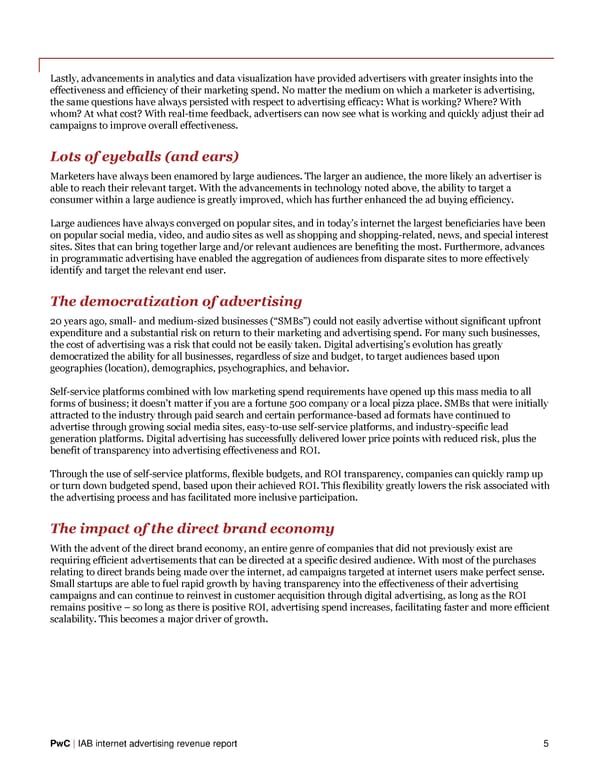Lastly, advancements in analytics and data visualization have provided advertisers with greater insights into the effectiveness and efficiency of their marketing spend. No matter the medium on which a marketer is advertising, the same questions have always persisted with respect to advertising efficacy: What is working? Where? With whom? At what cost? With real-time feedback, advertisers can now see what is working and quickly adjust their ad campaigns to improve overall effectiveness. Lots of eyeballs (and ears) Marketers have always been enamored by large audiences. The larger an audience, the more likely an advertiser is able to reach their relevant target. With the advancements in technology noted above, the ability to target a consumer within a large audience is greatly improved, which has further enhanced the ad buying efficiency. Large audiences have always converged on popular sites, and in today’s internet the largest beneficiaries have been on popular social media, video, and audio sites as well as shopping and shopping-related, news, and special interest sites. Sites that can bring together large and/or relevant audiences are benefiting the most. Furthermore, advances in programmatic advertising have enabled the aggregation of audiences from disparate sites to more effectively identify and target the relevant end user. The democratization of advertising 20 years ago, small- and medium-sized businesses (“SMBs”) could not easily advertise without significant upfront expenditure and a substantial risk on return to their marketing and advertising spend. For many such businesses, the cost of advertising was a risk that could not be easily taken. Digital advertising’s evolution has greatly democratized the ability for all businesses, regardless of size and budget, to target audiences based upon geographies (location), demographics, psychographics, and behavior. Self-service platforms combined with low marketing spend requirements have opened up this mass media to all forms of business; it doesn’t matter if you are a fortune 500 company or a local pizza place. SMBs that were initially attracted to the industry through paid search and certain performance-based ad formats have continued to advertise through growing social media sites, easy-to-use self-service platforms, and industry-specific lead generation platforms. Digital advertising has successfully delivered lower price points with reduced risk, plus the benefit of transparency into advertising effectiveness and ROI. Through the use of self-service platforms, flexible budgets, and ROI transparency, companies can quickly ramp up or turn down budgeted spend, based upon their achieved ROI. This flexibility greatly lowers the risk associated with the advertising process and has facilitated more inclusive participation. The impact of the direct brand economy With the advent of the direct brand economy, an entire genre of companies that did not previously exist are requiring efficient advertisements that can be directed at a specific desired audience. With most of the purchases relating to direct brands being made over the internet, ad campaigns targeted at internet users make perfect sense. Small startups are able to fuel rapid growth by having transparency into the effectiveness of their advertising campaigns and can continue to reinvest in customer acquisition through digital advertising, as long as the ROI remains positive – so long as there is positive ROI, advertising spend increases, facilitating faster and more efficient scalability. This becomes a major driver of growth. PwC | IAB internet advertising revenue report 5
 IAB Internet Advertising Revenue Report Page 6 Page 8
IAB Internet Advertising Revenue Report Page 6 Page 8